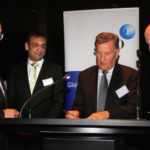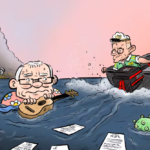Sudden death in young athletes a heart stopping event
We have all heard of seemingly fit and healthy athletes who have suddenly dropped dead. It’s tempting to think drugs or foul play were involved but Noby Leong says there is a genetic cause that can lead to sudden cardiac arrest.
Every four years, the Olympics comes around to remind us all of how lazy we really are. We watch the athletes run, jump, swim and do air kicks, thinking to ourselves that we should get out more and live healthier lives. But even the fit do fall, especially athletes suffering from a genetic disease of the heart called hypertrophic cardiomyopathy.
Athletes are at the peak of physical performance, and in theory, should represent the healthiest of us all. That’s what the world thought of sporting star Marc-Vivien Foe. Foe was a Cameroonian soccer player and international superstar of the 90s and early 2000s.
His skill was indisputable, playing for Cameroon, France and West Ham United. He was even offered a 3 million pound contract with Manchester United, which he turned down.
His health was undeniable, recovering successfully from a broken leg and bout of malaria during his career. But despite this, his life came to an abrupt end when he died unexpectedly and without warning, while playing the sport he loved.
Foe was playing for Cameroon in a 2003 FIFA Confederation Cup match against Colombia. It was the semi-final match with over 12,000 spectators. In the 72nd minute of the match, Foe, without any players around him, collapsed on the pitch.
Medics tried for 45 minutes to resuscitate him, but he eventually died in hospital. An autopsy revealed that, unknown to him, Foe suffered from hypertrophic cardiomyopathy.
Hypertrophic cardiomyopathy, or HCM, is a genetic disease where the muscles on one side of the heart enlarge and thicken. This can cause irregular heartbeats, palpitations and loss of circulation. In the worst cases, it can lead to sudden cardiac arrest and death.
HCM is a disease that is not compatible with elite sport, especially amongst the young. Due to the susceptibility of the heart, exercise becomes a trigger for heart failure. Over 50% of all deaths due to HCM occur during or shortly after physical activity.
One of the greatest tragedies of those who die from HCM is that they may not have even known they had it. Symptoms may never appear until it’s too late and of the symptoms that do appear, they may be something as simple as a headache.
Mandatory screening of HCM in elite athletes does occur in some countries, but it can be prohibitively expensive for something relatively rare. But even with screening, HCM may be overlooked as the physiology of a susceptible heart resembles a very healthy heart.
Elite sportspeople often have what is known as Athlete’s Heart. Their intense exercise regime naturally enlarges the heart and the resting pulse is slow, two things that are similar to a HCM heart. Therefore, differentiating between Athlete’s Heart and HCM can be quite challenging.
And while mandatory screening sounds like a good idea, disputes can arise over the efficacy of such programs. Several sporting bodies, including the International Olympic Committee (IOC), do adopt screening procedures. But there is some evidence to suggest that pre-screening does nothing to reduce sudden cardiac deaths.
Controversy intensifies when disqualification is imposed upon an athlete, especially if the initial diagnosis is wrong. Disqualification can lead to mental anguish, financial distress and legal implications for both the athlete and sporting body.
When a young athlete dies of hypertrophic cardiomyopathy, it’s a sudden and shocking event. Nobody expects it and nobody can quite believe it. For people like Marc-Vivien Foe, it’s horrible to think that the very sport they love betrays them entirely.
Noby Leong is your friendly neighbourhood scientists. He is a PhD candidate in Chemistry at the University of Adelaide and has an unhealthy obsession with food. He has previously worked as an advisor to the Minister for Youth of South Australia and is a fiction writer on the side. He is also co-founder and editor of the blog The Other Side of Science, which he encourages you to read from time to time.













